The Royal New Zealand Navy in the Interwar and WW2
 Circa 120 ships since the 1860s
Circa 120 ships since the 1860s
The Royal New Zealand Navy was the third Commonwealth fleet in importance:
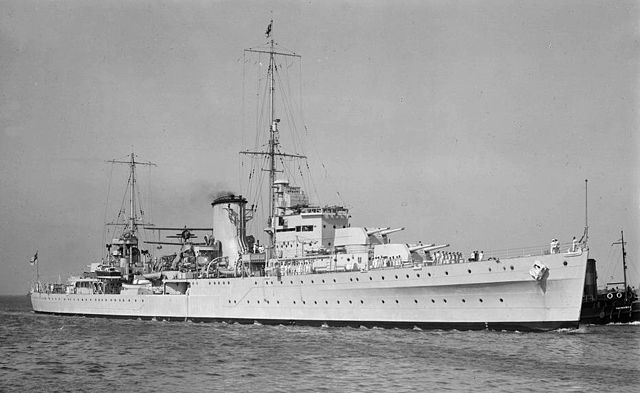
HMNZS Achilles
The commonwealth underdog: When thinking of commonwealth navies during the war, the three major fleets often cited were the RCAN or Royal Canadian Navy, the RAN or Royal Australian Navy, and the RNZN.
By pure laziness and reference to WW1 it was placed in the same bag as the RAN, and summup as the “Anzac navy”. It was true that during the great war, twenty years earlier, the RNZN did not existed. The population of New Zealand back then was not statistically large enough to justify the creation of a fully fledged navy. Instead, like for the Army, volunteers from the island chose to join the ranks of the RAN, which was an independent entity by that time; although many served with a battlecruiser and minor ships. The force grew in the interwar and really took off from 1941. During WW2, the Kiwi navy took part in many engagements, starting with the battle of Rio de la Plata, against the corsair Graf Spee, against the Regia Marina in the Mediterranean and across the Pacific, starting at Guadalcanal.
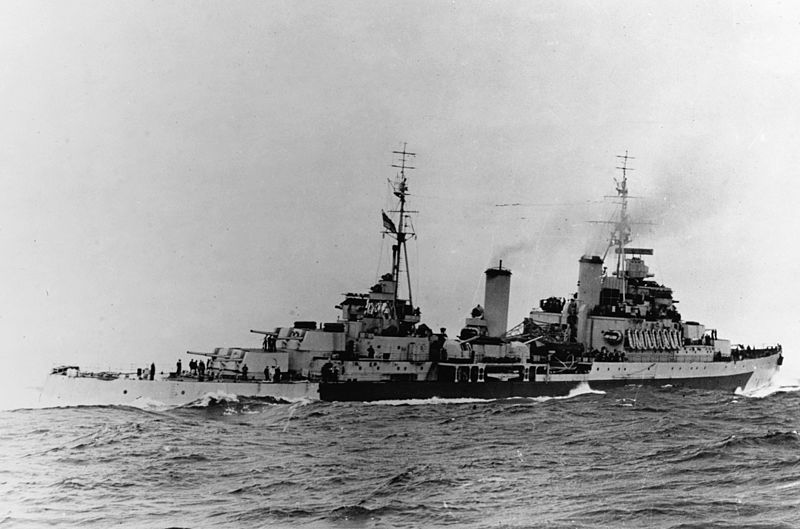
HMNZS Gambia underway circa 1945
Timeline of the Royal New Zealand Navy
Early premices
The Royal Navy ceased to assume the protection of New Zealand from the treaty of Waitangi in 1840 when the territory became a fully-fledged colony. British ships would stop however for some time, but there was never any considerations given for a permanent fleet. The settlers bought a gunboat after 1856 and the Waikato Flotilla operated from 1860, backed by a Naval Artillery Volunteer corps to provide harbour defence. In 1884 four spar torpedo boats were purchased and from 1887 ships of the Australasian Auxiliary Squadron were also funded by the government. Outside the Maori wars however (1845-1872), there were few occasions for the ‘Kiwis’ to take part in military actions before the Great War.
To support operations, an had hoc force was constituted with eight river boats, four armoured barges, five coastal boats and a naval dockyard. In 1863, the Australian-built Pioneer, built in Sydney, is followed by two sister ships, Koheroa and Rangiriri. In 1907, the local government acquired the NZS Amokura to start training cadets. This was the first commissioned ship for the local naval force, now part of a Dominion, a separate entity within the commonwealth and no longer a colony.
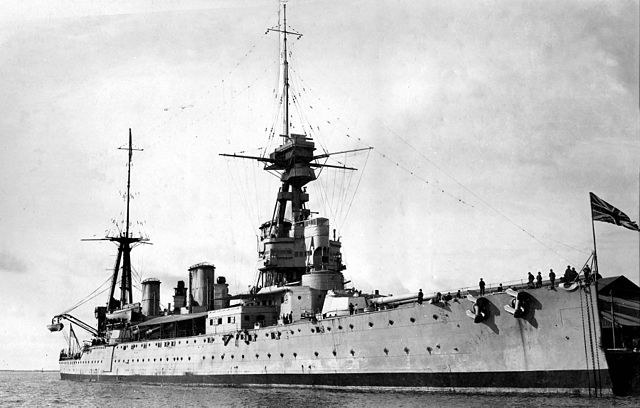
HMS New Zealand at Adelaide, Australia in 1919, during a celebration tour with Admiral Jellicoe onboard. She was broken up from december 1922, after a very short career of just ten years. This was imposed by the Washington treaty limitations.
The New Zealand Naval Forces (1913)
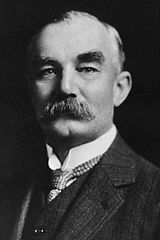 In 1909 the NZ Government showed its implication in the “dreadnought race” and loyalty to the crown, by financing a battlecruiser in construction, named accordingly HMS New Zealand. Many Kiwis enlisted in the Royal Navy to serve onboard and the ship had a significant career, taking part in the battles of Heligoland, Dogger Bank and Jutland. Odd fact, she once collided with HMAS Australia in 1916 but was repaired just in time to participate to the greatest naval battle of the XXth Century.
In 1909 the NZ Government showed its implication in the “dreadnought race” and loyalty to the crown, by financing a battlecruiser in construction, named accordingly HMS New Zealand. Many Kiwis enlisted in the Royal Navy to serve onboard and the ship had a significant career, taking part in the battles of Heligoland, Dogger Bank and Jutland. Odd fact, she once collided with HMAS Australia in 1916 but was repaired just in time to participate to the greatest naval battle of the XXth Century.
She was part of a distinctive naval force, the New Zealand Naval Forces created in 1913, and integrated during wartime in the RN. By the Defence Act 1913, through the will of James Allen (photo), the minister of defence, the local naval force created needed ships, for which the government purchased a first cruiser to make its core, HMS Philomel. This was a relatively old (1890) Pearl class, second class cruiser.
But her career was amazing, stretching until 1949, some 60 years. Even before 1913, the HMS Philomel has had an amazing career, taking part in the Anglo-Zanzibar War, her crew capturing the palace, the infamous Benin Expedition, Second Boer War and Battle of Colenso before being transferred to the Mediterranean and be transferred in 1913. Her first duty, under Cdt Percival Hall-Thompson was to train cadets of the future navy, she was later tasked to be the centerpiece of the New Zealand forces dispatched to occupy German Samoa.
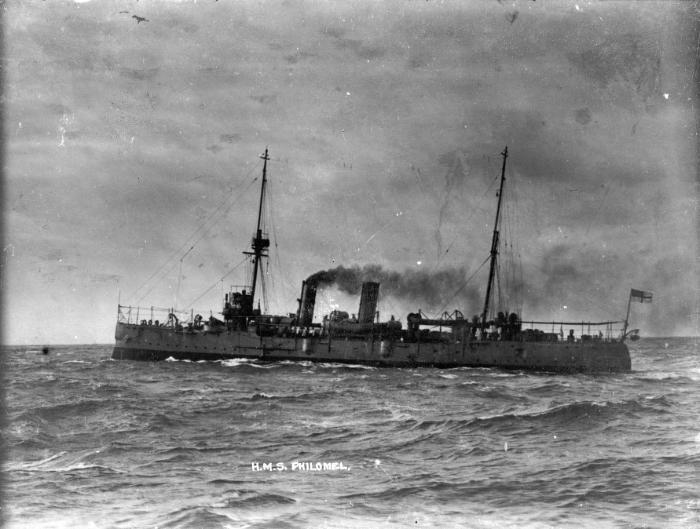
She was part of the New Zealand Expeditionary Force, escorting convoys to Australia, and up to the Middle East, chasing the ellusive cruiser Emden en route. She escorted French troopships to Port Said and was based here and sailed later to Malta, for an overhaul lasting until January 1915. Later her landing party met a superior Turkish force in southern Turkey, and the force had its first casualties. She served also in the Red Sea and in the Persian Gulf, and went on patrolling and escorting convoys in the Indian Ocean and red sea until March 1917, when she was partially disarmed, her British crew repatriated, and recommissioned as a depot ship in Wellington for minesweepers. HMS Philomel would serve from 1921 as a training base, and by 1925, her boilers and engines were removed to create more accommodation space. As a base she survived until 1941, and be recommissioned as HMNZS Philomel.
New Zealand Division of the Royal Navy (1921-41)
After the war, in 1921 this unit became the Royal Navy New Zealand Division. The latter grew to a strenght of fourteen ships. At first, the cruiser Chatham along with the sloop Veronica were acquired in 1920, and later in 1922, the sloop Torch and HMS Laburnum, then HMS Dunedin in 1924 and two years later, HMS Diomede and the minesweeper HMS Wakakura. But by far the most impressive acquisitions were the cruisers HMS Achilles (joined 31 March 1937) and HMS Leander. Both were soon famous cruisers of the Leander class. They replaced HMS Diomede and Dunedin from 1937.
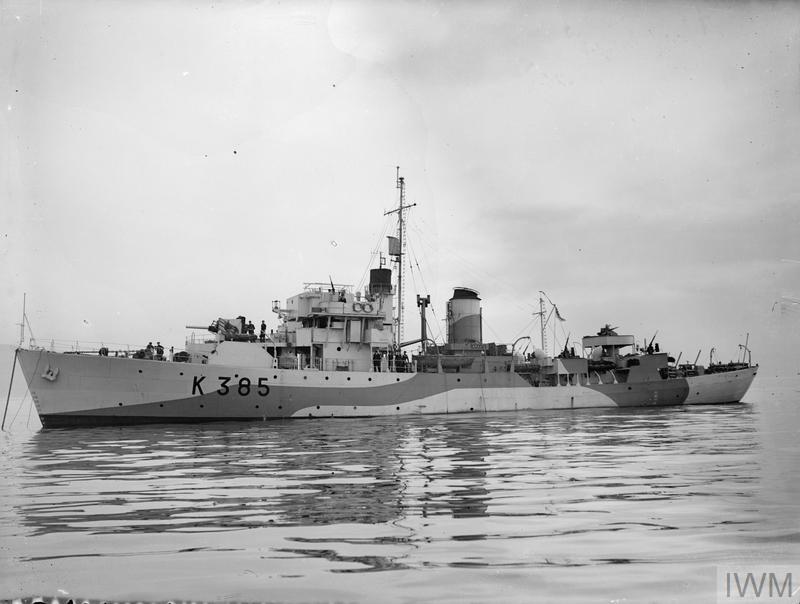
HMNZS ARABIS, NEW FLOWER CLASS CORVETTE FOR NEW ZEALAND. 24 MARCH 1944, GREENOCK. (A 22520) HMNZS ARABIS. IWM coll.
Creation of the Royal New Zealand Navy on 1st october 1941
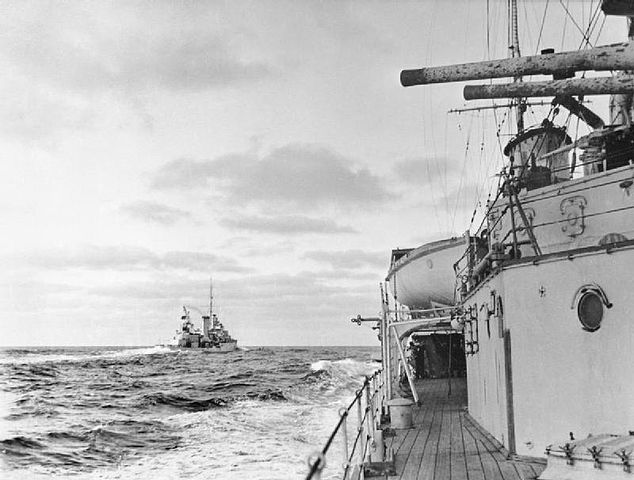
HMS Achilles as seen from HMS Ajax during the Battle of the River Plate in December 1939.
While in September 1939 the RNZN formally declared war on Germany, the Navy had little time to prepare, but the HMS Achilles would strike the first blow, participating in the first naval battle of WW2: The famous duel with KMS Graf Spee. The cruiser faced the six 280 mm naval guns of the hybrid German “pocket” battleship alonsgide HMS Ajax and HMS Exeter this 13 December 1939.
Due to the lower range and smaller guns of both Leander class cruisers, the Graf Spee concentrated fire on the 8-in armed Exeter, damaging her badly to the point both light cruisers surged to the rescue, spreading a salvation through intense counter-battery fire from their combined sixteen 6-inches and a thick smoke cloud. This forced the Geran ship to divert fire on the Ajax and Achilles closing to 13,000 yd (12,000 m), saving the wounded heavy cruiser from certain destruction. Later on, both cruisers would shadow the Graf Spee to Montevideo and were part of the blockading fleet.
When the Royal New Zealand Navy was created, the ship was recommissioned HMNZS Achilles and served in the Pacific with the USN, closer to home. The Japanese threat was really present indeed, and the RAN also largely participated in the early heavy fightings against an unstoppable IJN. Achilles was bombed off New Georgia, repaired, and served until V-Day with British Pacific Fleet. Despite the reluctance of Prime Minister Peter Fraser the Navy was now fully independent. The other transferred cruiser, HMNZS Leander, soldiered with the the New Zealand Expeditionary Force sent in the Mediterranean from 1940, the Red Sea, and the Indian Ocean. She sank there the Italian auxiliary cruiser Ramb I and was sent in the Pacific later, helped destroying the Japanese cruiser Jintsu before being torpedoed at the battle of Kolombangara, which sent her in repairs until the end of the war.
Other wartime actions of the Royal New Zealand Navy
As the war progressed, the RNZN grew in size up the end of the war accumulating over 60 ships in service. These New Zealand vessels participated in the British and Commonwealth fight in Europe and in the Pacific. Many of these ships also played their part in the defence of New Zealand home waters. The NZ ships mostly searched for German raiders, and others patrolled for any sign of a threat of Japanese invasion in 1942.
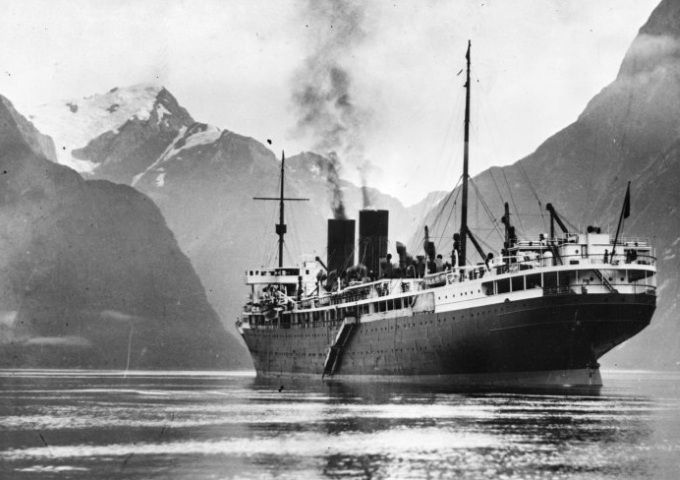
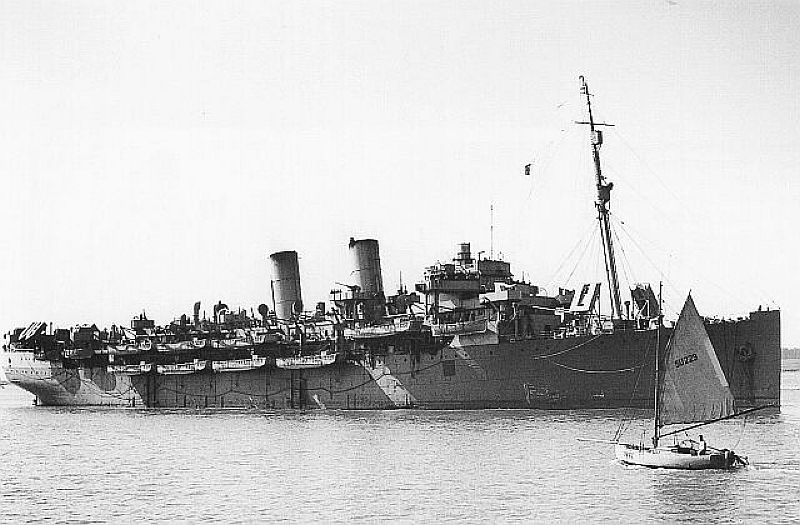
HMNZS Monowai in Milford Sound in February 1933 (top) and in WW2.
Merchant ships were requisitioned by the government and added to the Navy list pressed in defence with various armaments added. Probably one of the most prominent was HMNZS Monowai. This armed auxiliary cruiser saw action against IJN submarine I-20 off Fiji in 1942, which torpedoed but missed her. This former Peninsular and Oriental Steam Navigation Company (P&O) merchant vessel was rearmed and operated from Devonport Naval Base in Auckland. She has been requisitioned by 21 October 1939 but only operational in August 1940. She was later requisitioned by the British Ministry of War Transport and converted as a Landing Ship, Infantry (Large) and reconverted, operating in 1943-44.
In 1941–1942, an agreement between New Zealand and the United States made the RNZN Pacific command integrated into the United States Navy’s South West Pacific Area command. NZ ships joined the United States 7th Fleet Task Force.
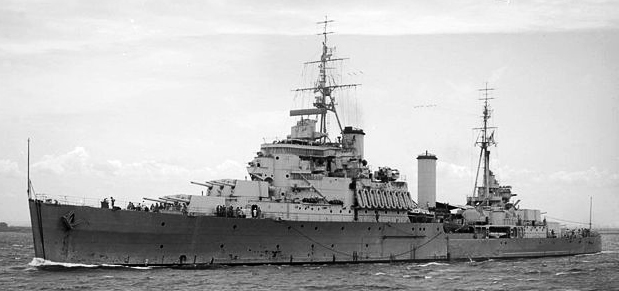
HMS Gambia 1945
In 1943, the Crown colony class cruiser HMS Gambia was transferred to the RNZN. HMNZS Gambia was by far the most potent vessel of the RNZN by November 1944. She joined the brand new British Pacific Fleet, a joint British Commonwealth military formation formed in Sydney. Gambia and Achilles joined the new unit, taking part in the Battle of Okinawa and Sakishima Islands campaign. By August 1945, HMNZS Gambia carried the officials and representative of New Zealand at the surrender of Japan.
Complete list:
Cruisers:
HMNZS Achilles, HMNZS Gambia, HMNZS Leander
Corvettes:
HMNZS Arabis, HMNZS Arbutus: WW1 Flower class ASW corvettes.
Armed Merchant Cruiser: HMNZS Monowai
Minesweepers/ASW patrol trawlers: HMNZS Moa, Tui, Kiwi
Support vessel: HMNZS Matai
Coast defence force: 25th Fairmile Flotilla
As part of the 7th TF, RNZN Achilles and Leander participated to Operation WATCHTOWER, covering landings landed on Guadalcanal in 7 August 1942. Followed six major naval engagements, Savo Island 8/8/1942, the Eastern Solomons 24/8/1942, Cape Esperance on 11-12/10/1942, Santa Cruz Islands 26/10/1942, Guadalcanal 12-15/11/1942 and Tassafaronga 30/11/1942. At Guadalcanal in January 1943, Kiwi and Moa spotted and targeted the IJN submarine I-1 (Eiichi Sakamoto). TF17 was constituted around USS Yorktown under read-admiral Frank J. Fletcher.
Kiwi grenaded the submarine, succeeding in disabling the I-1 port electric motor and flooding her aft storeroom. However later she emerged and escaped during the night, only to be spotted again and fired upon, and later even rammed thrice by Kiwi. The small converted Tug did caused sufficient damage with Moa to sink the IJN submarine, earned a DSO for C. BUCHANAN, signalman by admiral Halsey.
HMNZS Achilles and Leander escorted convoys of troops and supplies to Guadalcanal while the 25th Minesweeping Flotilla (HMNZS Matai, Tui, Moa, Kiwi) started their ASW patrols from December 1942. On 5 January 1943 HMNZS Achilles X-turret was hit by a bomb and during the night of 29-30 January 1943, HMNZS Kiwi and Moa eventually sank (as seen above) the sink Japanese submarine I-1, but the latter was avenged as Moa was sank on 7 April 1943 at Tulagi. By 13 July, Leander was badly damaged at the Battle of Kolombangara but was later repaired at Boston. As remembered by Petty Officer Brown, night fighting over IJN supplies was near constant around Guadalcanal.
The RNZN would have the occasion of firing the last shots of WW2: Petty Officer Wireman R.B. Harvey remembered the bombardment of HMNZS Gambia of Kamaishi. Lieutenant S.W. Hicks RNZNVR also remembered the unknown massive IJN submersible they crossed with HMNZS Monowai at the Suva Harbour entrance, fired upon but not sank on 16 January 1942. Among the POWs in January 1945 were a significant numbers of RNZN Fleet Airmen. They were murdered in Singapore in July 1945.
Read More/Src
Conway’s all the world’s fighting ships 1922-1947
//navymuseum.co.nz/hmnzs-kiwi-moa-bird-class-corvettes/
//navymuseum.co.nz/wwii-the-royal-new-zealand-navy-and-the-pacific-campaign-1941-1945/
S. D. Waters, The Royal New Zealand Navy: Official History of New Zealand in the Second World War 1939-45, Wellington
War History Branch Department of Internal Affairs, 1956, pp. 538.
Baxter & Haberfield reports 1946 – Baxter Personal Collection ref. EZB0018.
HMNZS Monowai Ship’s log for Friday 16 January 1942
John Winton, The Forgotten Fleet, London: Michael Joseph, 1969, pp. 98-99.
S. D. Waters, The Royal New Zealand Navy: Official History of New Zealand in the Second World War 1939-45,
en.wikipedia.org/wiki/Royal_New_Zealand_Navy
en.wikipedia.org/wiki/New_Zealand_Naval_Forces
en.wikipedia.org/wiki/HMNZS_Monowai_(F59)

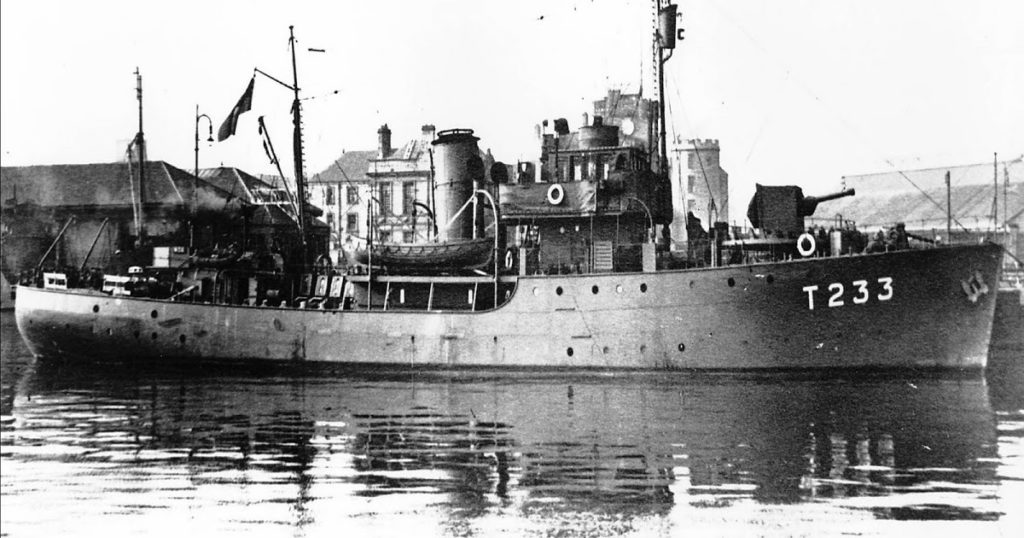

 Latest Facebook Entry -
Latest Facebook Entry -  X(Tweeter) Naval Encyclopedia's deck archive
X(Tweeter) Naval Encyclopedia's deck archive Instagram (@navalencyc)
Instagram (@navalencyc)





 French Navy
French Navy Royal Navy
Royal Navy Russian Navy
Russian Navy Armada Espanola
Armada Espanola Austrian Navy
Austrian Navy K.u.K. Kriegsmarine
K.u.K. Kriegsmarine Dansk Marine
Dansk Marine Nautiko Hellenon
Nautiko Hellenon Koninklije Marine 1870
Koninklije Marine 1870 Marinha do Brasil
Marinha do Brasil Osmanlı Donanması
Osmanlı Donanması Marina Do Peru
Marina Do Peru Marinha do Portugal
Marinha do Portugal Regia Marina 1870
Regia Marina 1870 Nihhon Kaigun 1870
Nihhon Kaigun 1870 Preußische Marine 1870
Preußische Marine 1870 Russkiy Flot 1870
Russkiy Flot 1870 Svenska marinen
Svenska marinen Søværnet
Søværnet Union Navy
Union Navy Confederate Navy
Confederate Navy Armada de Argentina
Armada de Argentina Imperial Chinese Navy
Imperial Chinese Navy Marinha do Portugal
Marinha do Portugal Mexico
Mexico Kaiserliche Marine
Kaiserliche Marine 1898 US Navy
1898 US Navy Sovietskiy Flot
Sovietskiy Flot Royal Canadian Navy
Royal Canadian Navy Royal Australian Navy
Royal Australian Navy RNZN Fleet
RNZN Fleet Chinese Navy 1937
Chinese Navy 1937 Kriegsmarine
Kriegsmarine Chilean Navy
Chilean Navy Danish Navy
Danish Navy Finnish Navy
Finnish Navy Hellenic Navy
Hellenic Navy Polish Navy
Polish Navy Romanian Navy
Romanian Navy Turkish Navy
Turkish Navy Royal Yugoslav Navy
Royal Yugoslav Navy Royal Thai Navy
Royal Thai Navy Minor Navies
Minor Navies Albania
Albania Austria
Austria Belgium
Belgium Columbia
Columbia Costa Rica
Costa Rica Cuba
Cuba Czechoslovakia
Czechoslovakia Dominican Republic
Dominican Republic Haiti
Haiti Hungary
Hungary Honduras
Honduras Estonia
Estonia Iceland
Iceland Eire
Eire Equador
Equador Iran
Iran Iraq
Iraq Latvia
Latvia Liberia
Liberia Lithuania
Lithuania Mandchukuo
Mandchukuo Morocco
Morocco Nicaragua
Nicaragua Persia
Persia San Salvador
San Salvador Sarawak
Sarawak Uruguay
Uruguay Venezuela
Venezuela Zanzibar
Zanzibar Warsaw Pact Navies
Warsaw Pact Navies Bulgaria
Bulgaria Hungary
Hungary

 Bundesmarine
Bundesmarine Dutch Navy
Dutch Navy Hellenic Navy
Hellenic Navy Marina Militare
Marina Militare Yugoslav Navy
Yugoslav Navy Chinese Navy
Chinese Navy Indian Navy
Indian Navy Indonesian Navy
Indonesian Navy JMSDF
JMSDF North Korean Navy
North Korean Navy Pakistani Navy
Pakistani Navy Philippines Navy
Philippines Navy ROKN
ROKN Rep. of Singapore Navy
Rep. of Singapore Navy Taiwanese Navy
Taiwanese Navy IDF Navy
IDF Navy Saudi Navy
Saudi Navy Royal New Zealand Navy
Royal New Zealand Navy Egyptian Navy
Egyptian Navy South African Navy
South African Navy






























 Ukrainian Navy
Ukrainian Navy dbodesign
dbodesign